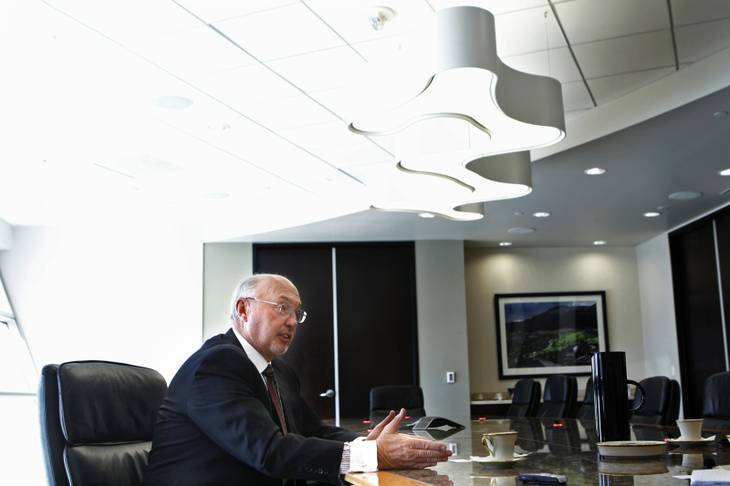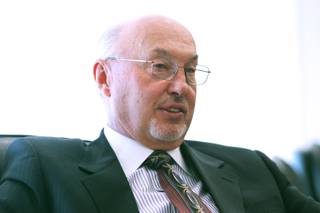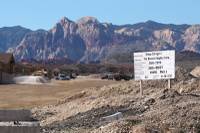Developer Kevin Orrock has a job that many Las Vegans think is already done — building Summerlin.
But he has plenty of work ahead.
Orrock, president of the master-planned community for Howard Hughes Corp., oversees the development of the 22,500-acre project. Summerlin runs along the western rim of the Las Vegas Valley and has roughly 100,000 people in 40,000 homes.
The community, however, is planned for more than 200,000 residents in 80,000 homes and has a projected completion date of 2039. Summerlin has more than 5,000 acres of undeveloped residential land and 890 acres of commercial land up for grabs.
Summerlin is known for pricey homes and a high quality of life, but it was not immune from the recession. Most notably, the massive retail project Shops at Summerlin Centre was mothballed in October 2008 by then-owner General Growth Properties. The steel skeleton remains off the 215 Beltway.
But things are looking up. Howard Hughes Corp., a spin-off from General Growth, said last year the project was back on track with Macy’s and Dillard’s as anchor stores.
The retail hub, now known as the Shops at Summerlin, is expected to open in late 2014 with more than 125 stores and restaurants. When it does, company officials expect to sell an additional $100 million of residential land, according to CEO David Weinreb.
The company sold $11 million of residential land in Summerlin in 2010. That soared to $30.9 million in 2011 and inched up to $31 million last year.
Orrock, born in the small mining town of Pioche, 180 miles north of Las Vegas, started working for the famed aviator Howard Hughes in 1974 in his finance department. Orrock never met the reclusive billionaire, who died in 1976.
Hughes had acquired the massive property now known as Summerlin in a land swap with the federal government in 1952. He initially wanted to build research and development facilities for his Southern California aircraft company but ended up doing nothing with the land.
After he died, the company overseeing his holdings drew up plans for Summerlin. The first residents moved there in 1991.
Orrock has stuck with the Hughes organization through its various mergers and spin-offs. He sat down with VEGAS INC in his Summerlin offices to talk about the master-planned community.
How was it last year for sales and development in Summerlin?
Actually, relatively speaking, very good. In Summerlin, our new-home sales were more than double the previous year. The demand was there, and we sold about 470 units in 2012. Three years ago, the valley was dead. There was nothing going on.
The company announced last year that the Shops at Summerlin is back on track. Has that improved home sales or development yet?
I think it’s raised a level of interest, but I think you’ll really see the impact when construction actually starts, and that will be very soon. Summerlin is 40 square miles, but we’ve only got about 1 million square feet of retail here and it’s almost 100 percent occupied. With most other communities, you have a town center. We’re 22 years into this project with no town center. Construction should start in either the first quarter or very early in the second quarter this year.
More acres and lots were sold in the first nine months of 2012 compared with same period in 2011, but the price per acre of single-family homes went down by about 20 percent. Why is that?
Statistics are deceiving, because it’s a mix of products. We sell two types of land — finished lots and super pads. Super pads are large parcels — 15 to 20 acres — and the builders develop everything. It’s raw land. With finished lots, we do all the infrastructure and then sell the land to the builders; all they have to do is pull the building permits and they’re ready to go. Those cost more to buy. We shifted from finished lots to super pads last year, so the price per acre went down.
Why did you shift?
It’s a function of the market. You couldn’t justify finished lots when the prices dropped. When we started, our model was selling super pads. Most developers don’t do them because they get incremental revenue from them.
Only one acre of retail was sold in the first nine months of 2012. Why was that?
There’s a good reason for that: I’m not going to sell retail in front of the Shops at Summerlin. That’s the focus.
You’re not looking to do other retail developments?
Not unless it happens to be something unique that we wouldn’t be doing over here at the Shops. But we’d look at it.
General Growth Properties sold all 32 of its Summerlin office buildings in September for almost $120 million. The properties were half-vacant. I’d be surprised if anyone wants to build more office space here. Are you expecting any? Are you pushing for more office development?
The steel high-rise you see at the Shops at Summerlin is an 8-story office building. We’ll do that, but we’re also going to strategically look at opportunities moreso than I think we did under the old ownership structure.
Can you elaborate on the differences between you and General Growth?
GGP is one of the largest retail real estate investment trusts in the country. Their interest in owning office and apartments didn’t really fit in to their strategic plan. We own large land assets that can be developed for all kinds of opportunities.
Summerlin has the furthest build-out date, 2039, of any Howard Hughes Corp. master-planned community. Why is it so far away?
We have more land. We have entitlements for 40,000 more homes in Summerlin. Most of our commercial, the Shops at Summerlin, is yet to be developed. This thing started in '91. Originally, it was a 50-year build out. We have 22,500 acres. It’s going to take a while to build that out. This project is 20 years old, so a lot of people think it’s done. We’re not near done.
What is the demand for custom homes? The company’s financial reports say the price per acre of custom home lots in Summerlin plunged in recent years but is picking up.
When the market turned down, everything turned down, from entry-level to the highest-priced homes. Las Vegas was kind of the epicenter for everything that went bad. But we’ve got a lot of activity in The Ridges right now. There are probably 25 custom homes under construction there and another 15 to 20 in the pipeline.


